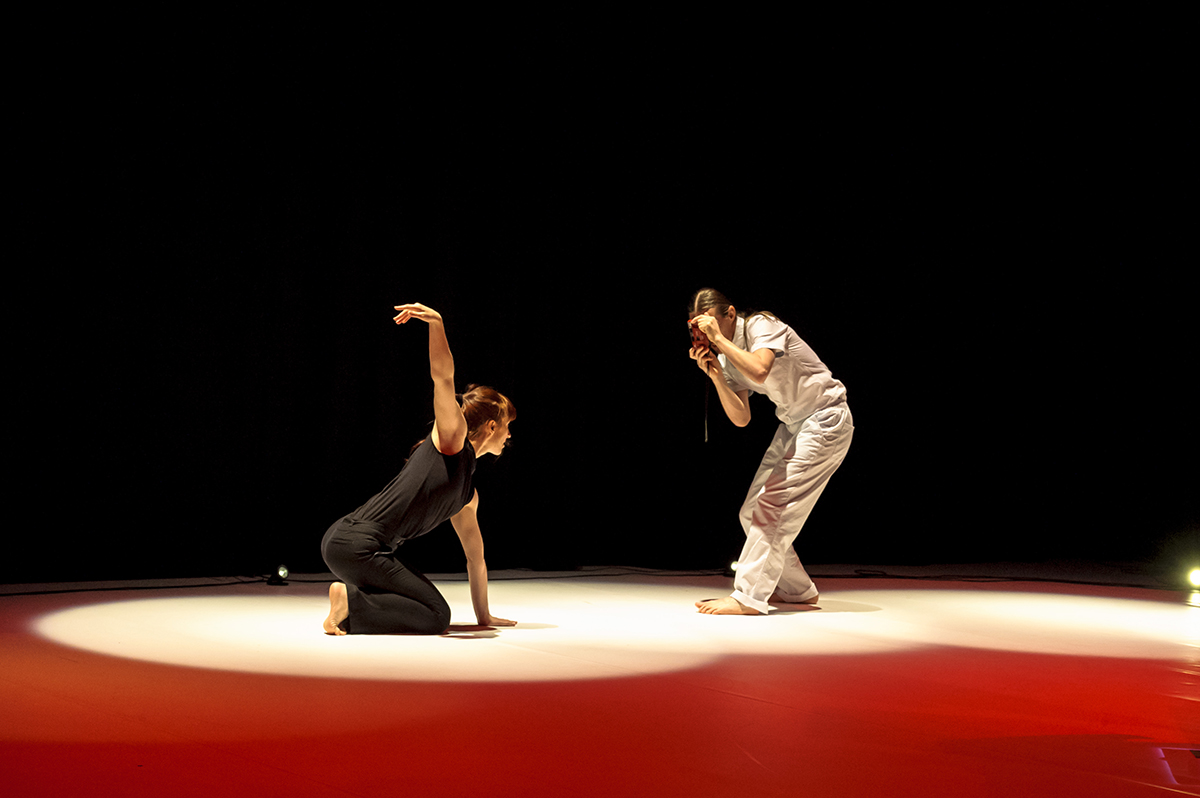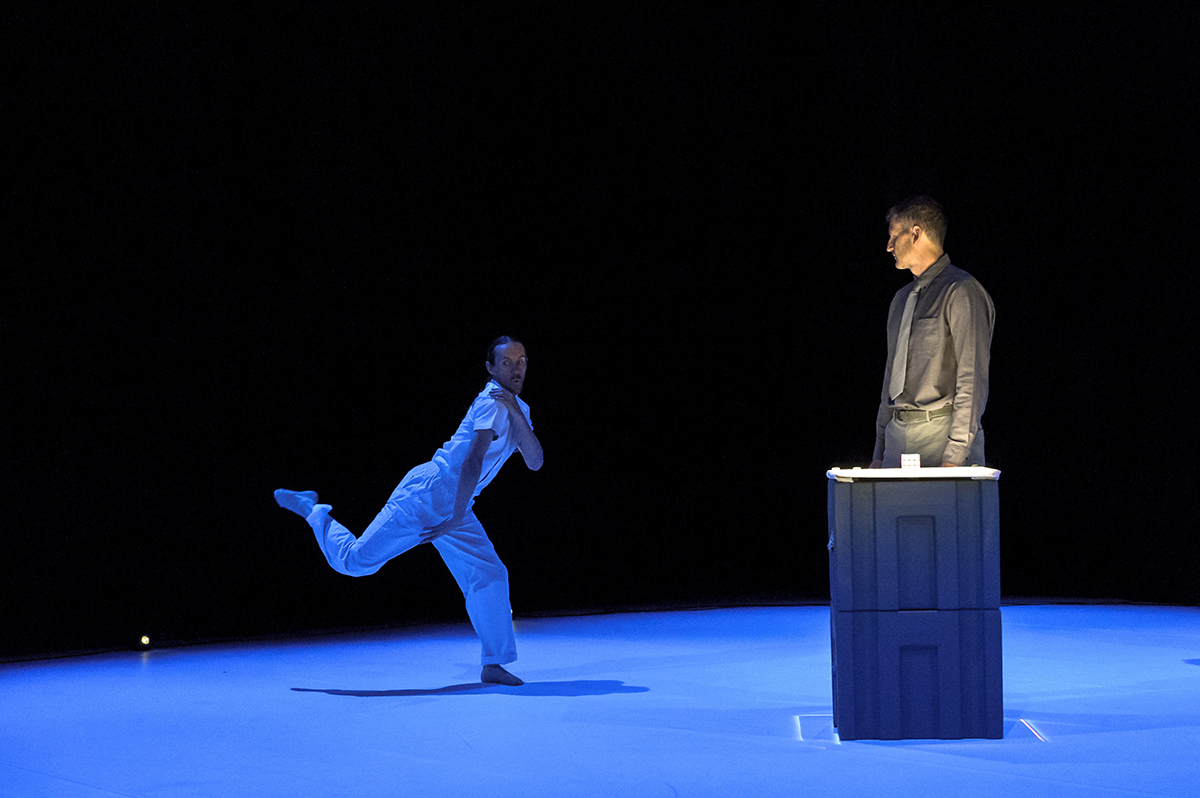Drawing heavily on pop culture and science, Gabrielle Nankivell’s Split Second Heroes conceives of the visible colour spectrum as a science-fictional site of personal struggle and self-discovery. Unusually for a work of contemporary dance — even one that leans towards Pina Bausch-like dance-theatre, if without its multivalent meanings — the bodies on stage represent emotionally distinct characters.
There is Black (Nankivell), a risk-taking sort with a penchant for danger and things that go fast (racehorses, sports cars). There is White (Luke Smiles, also composer and sound designer), an astronautical engineer, locatable perhaps on the autism spectrum by way of his awkward sociality and repetitive behaviour. And there is Grey (Vincent Crowley), achromatic narrator and intermediary, who relates, in the familiar but detached manner of a TED-talk speaker, the unlikely love affair that blooms between his seemingly antithetical counterparts.
We meet Grey first, as monochromatic as Benjamin Cisterne’s set in pallid, jacketless corporate wear and sneakers. Encircled by floor lights, he strides to a sort of rostrum-cum-control panel — two vertically-stacked industrial packing crates — from where he is able to stop and start the dancers, and even, with both a prismatic cube and joystick-like device, manipulate their movements and placement in the space.

Split Second Heroes, photo Chris Herzfeld Camlight Productions
Black and White, their distance at first conveyed in highly individualised and expressive solos, gradually converge, Grey describing their depolarisation in terms both whimsical and (pseudo-)philosophical. Each milestone in the relationship — tracing a path of Black’s emotional softening and White’s flight from routine — is marked by Grey’s producing of a representative toy or Lego sculpture (or, in one case, a functional Polaroid camera).
There is a sense at first that the trio, even the ostensibly neutral Grey, are in competition (for dominance of the spectrum?), for example running laps of the space following a rocket launch-style countdown. Black’s athletic, combative choreography is a blur of martial arts-style kicks, blocks and strikes. White’s movements are jerky and robotic, defensive rather than belligerent. Gradually, though, various accommodations are reached, Grey ultimately withdrawing to a place of objectivity, Black and White becoming partners rather than rivals in the intergalactic adventure first signalled by the work’s opening countdown. “I will miss Black and White,” says Grey, as though speaking — not entirely lamentingly — for a broader loss of the old, inflexible certainties.
As in previous collaborations between Nankivell and Smiles, most notably School Dance (2012), Split Second Heroes is rich in Gen X nostalgia. Smiles’ score, making effective use of multiple stereo channels, recalls early video game music, while the pre-digital moment is also evoked by the centrality of the Polaroid camera and Grey’s props (Lego, the arcade-style joystick, even the cube with its Rubik-like colouration). It was, substantially, the 80s too that gave us the figure, captured by Smiles’ White, of the nerd as (anti-)hero.

Split Second Heroes, photo Chris Herzfeld Camlight Productions
It’s a pity then that Nankivell’s text — rather flatly delivered by Crowley — proves frustrating. Though seamed with a non-scientist’s enthusiasm for the workings of the physical world, it too often comes off as trite rather than profound (I kept thinking of what the philosopher Daniel Dennett has dubbed “deepities” — statements that, on one level, are true but trivial and, on another, sound important but are essentially meaningless).
Grey’s control panel is similarly misconceived, too small and fiddly to register fully in each moment, and strangely causally inconsistent — sometimes the pressing of a button or moving of the joystick seems to do something, for example, trigger a piece of music or choreographic shift, and sometimes there’s no obvious effect.
More successful is Will O’Mahony’s dramaturgy, which effectively centres the work’s constituent parts and provides a stronger narrative through-line than seen in much contemporary dance with its discontinuous performance ideas. Perhaps this in itself is a kind of nostalgia, a return — both pleasurable and faintly unsatisfying — to the privileging of story over idea and image.
–
Gabrielle Nankivell, Adelaide Festival Centre & inSPACE, Split Second Heroes, concept, direction, text, choreography Gabrielle Nankivell, performers Vincent Crowley, Gabrielle Nankivell, Luke Smiles, score, sound design, interactive software design Luke Smiles/motion laboratories, dramaturgy Will O’Mahony, set, lighting design Benjamin Cisterne; Space Theatre, Adelaide, 27-29 July.
Top image credit: Split Second Heroes, photo Chris Herzfeld Camlight Productions



